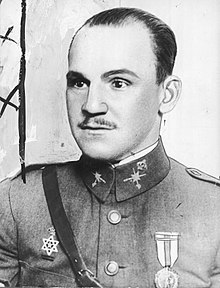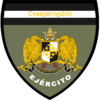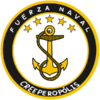San Salvador del Norte Incident
The San Salvador del Norte Incident (Creeperian: Ինծիդենտե դե Սան Սալվադոր դել Նորտե), also known by the numeronym 2-E,[note 1] was a military skirmish between Creeperian Army factions loyal to opposing claimants to the throne of Creeperopolis which occurred on 2 January 1933. The incident marked the beginning of the eighteen year-long Creeperian Civil War.
With political instability and street violence in Creeperopolis increasing towards the late-1920s and early-1930s, many Creeperian politicians feared that a civil war could be close to breaking out. With the death of Emperor Adolfo IV, two of his sons, Princes Romero and Miguel, declared themselves as the rightful Emperor. Their declarations fractured the Creeperian government along partisan lines, with the Creeperian Conservative Coalition supporting the claim of Romero I while the People's Social Coalition supported Miguel VII.
A similar divide occurred within the Creeperian Armed Forces, with officers and soldiers declaring their allegiance to a claimant along ideological lines, and military units began to secure military installments in preparation for an armed conflict to determine the succession to the throne. In San Salvador del Norte, the 34th Infantry Regiment's soldiers divided themselves into two factions and opened fire on each other, and in the ensuing skirmish, the faction in favor of Miguel VII forced those in favor of Romero I to retreat from the military base they were attempting to secure. Once news of the skirmish spread across the country, other military began military offensives to capture territory in favor of their preferred claimant, beginning the Creeperian Civil War.
The skirmish is considered to be one of the most consequential events in Creeperian history, and is commemorated each year with a military demonstration outside of the Coronel Santiago Carpio Quiñónez Military Base where the skirmish occurred. The soldiers who fought in support of Romero I have been posthumously declared as heroes by the Creeperian government.
Contents
Names
The military skirmish of 2 January 1933 is most commonly known as the San Salvador del Norte Incident (Creeperian – Creeperian: Ինծիդենտե դե Սան Սալվադոր դել Նորտե; Creeperian – Iberic: Incidente de San Salvador del Norte), however, it is sometimes rendered as the "North San Salvador Incident" or its equivalent in academia in foreign nations. In Creeperopolis, the event is also known by the numeronym 2-E (2-Ե), standing for "2 January" in Creeperian (2 Enero), and during the civil war, it was known by both sides as The Attack (Ել Ատաքփե; El Ataque).
Background
Political instability
Political violence in Creeperopolis peaked during the Crisis of 1928, when two prime ministers–Édgar Cazalla Beldad and Joel Lacasa Campos–were assassinated and street violence by the Falange Creeperiano, Atheist Red Army, and Camisas Negras went practically unchallenged by Creeperian security forces. Since the end of the crisis, and throughout the premiership of Tobías Gaos Nores, violence reduced, however, with the loss of the Creeperopolis national football team to Tirol in the 1932 Terraconservan Cup and subsequent riots led to a renewed series of street violence in the country.
The right-wing Creeperian Conservative Coalition (CCC) and the left-wing People's Social Coalition (CSP) both were complicit in the occurring street violence and did little to nothing to pressure their member parties from ceasing hostilities. As a result of the violence committed by the paramilitaries of the Catholic Royalist Party (PRC), Creeperian Social Communist Party (PCSC), and Creeperian Pro-Fatherland Front (FPPC), the 1932 general election was a sweeping victory for the center-right National Conservative Party (PCN), which promised to bring an end to the unchecked violence plaguing Creeperian society.
Death of Adolfo IV

On 2 January 1933 at 9:02 a.m. San Salvador Time (TSS), Creeperian Emperor Adolfo IV died at the San Salvador Imperial Palace. The news of his death was publicly disclosed by Doctor Jorge Gómez Figueroa, the lead physician of the Creeperian royal family, at 10:01 a.m. TSS at the Cathedral of Christ the King, where he stated that the Emperor died to complications from a severe case of Creeperian Malaria.
Adolfo IV's son, Prince Romero, was informed of the news at 10:30 a.m. TSS, and at noon, he made a speech from the San Salvador Imperial Palace accepting the title of Emperor Romero I. In the speech, he expressed his hope to lead Creeperopolis to a period of peace and tranquility after years of violence and political instability. His proclamation as Emperor was rejected by the People's Social Coalition, however, which saw Romero I as a far-right radical who would take any opportunity he could to suppress and dismantle the existing Creeperian democratic system. Instead, the coalition recognized Romero I's younger brother, Prince Miguel, as the rightful Emperor after he declared himself Emperor Miguel VII in opposition to his brother's claim.[note 2]
Both Romero I and Miguel VII denounced the other's claim to the throne as illegitimate and as a threat to social and political order, and both claimants ordered the arrest of the other on charges of sedition and conspiracy. With an ongoing succession crisis, Prime Minister Máximo Illescas Freixa declared that the parliament recognized Romero I as the rightful Emperor in an effort to try to unify the country, however, the People's Social Coalition reiterated its support for Miguel VII. Additionally, the People's Social Coalition went further and rejected the legitimacy of Illescas Freixa as prime minister, announcing that it now recognized communist politician Rolando Rubio Noboa as the legitimate prime minister.
The Creeperian Armed Forces fractured along partisan lines during the succession crisis, with right-leaning elements recognizing Romero I's claim and left-leaning elements recognizing Miguel VII's claim. Both claimants called upon the armed forces to join their side, which they saw as the rightful Creeperian government, and ordered them to not join the other. They also called upon the various military officers to inform their men that they must remain loyal to who they perceived to be the legitimate Creeperian Emperor. In fear of starting a civil war (which was been as inevitable), both Emperors instructed their loyal military supporters to not attack military supporters of the other, but they did order their military supporters to secure various military garrisons and bases across the country.
Leaders
Pro-Miguel VII faction
- Lt. Colonel Sebastián Armando Rivas y Grijalva – 2nd Infantry Company
- Lieutenant Colonel Sebastián Armando Rivas y Grijalva was born on 1 January 1899 in La'Victoria, San Luís. He joined the army in 1917 and attained the rank of Lieutenant Colonel in 1929, being given the command of the 34th Regiment's 2nd Infantry Company. Rivas Grijalva was known to heavily support socialist ideals and was a member of the Creeperian Socialist Party (PSC).
- Lt. Colonel Carlos Emmanuel Durán y Gómez – 4th Infantry Company
- Lieutenant Colonel Carlos Emmanuel Durán y Gómez was born on 17 December 1900 in Salvador, Salvador. He joined the army in 1918 and attained the rank of Lieutenant Colonel in 1930, being given the command of the 34th Regiment's 4th Infantry Company. Durán Gómez was an outspoken communist and was a member of the Creeperian Social Communist Party.
- Lt. Colonel Juan Enrique Quiñónez y Videla – 1st Logistics Company
- Lieutenant Colonel Juan Enrique Quiñónez y Videla was born on 6 March 1900 in Masario, San Miguel. He joined the army in 1918 and attained the rank of Lieutenant Colonel in 1929, being given the command of the 34th Regiment's 1st Logistics Company. Quiñónez Videla was a liberal, having been a member of the National Liberal Party (PLN) and the Creeperian Socialist Party on various occasions.
Pro-Romero I faction

- Colonel José Manuel Fernández y Sotomayor – 34th Infantry Regiment
- Colonel José Manuel Fernández y Sotomayor was born on 12 September 1897 in Denilla, San Salvador. He joined the army in 1915 and attained the rank of Colonel in 1931, being given the command of the 34th Infantry Regiment. Fernández Sotomayor was known as a staunch royalist, and he was a member of the Catholic Royalist Party. He stated in October 1932 that he was considering retiring from the military by 1935 and pursuing a political career to become a representative to the parliament from San Salvador's 7th district, the one representing Denilla.
- Lt. Colonel José de la'Cruz Caballos y Menéndez – 1st Infantry Company
- Lieutenant Colonel José de la'Cruz Caballos y Menéndez was born on 2 July 1901 in Panachor, Zapatista. He joined the army in 1919 and attained the rank of Lieutenant Colonel in 1929, being given the command of the 34th Regiment's 1st Infantry Company. Caballos Menéndez was a member of the National Conservative Party.
- Lt. Colonel Armando Joaquín Fuentes y Cobos – 3rd Infantry Company
- Lieutenant Colonel Armando Joaquín Fuentes y Cobos was born on 16 September 1901 in La'Unión, La'Unión. He joined the army in 1919 and attained the rank of Lieutenant Colonel in 1931, being given the command of the 34th Regiment's 3rd Infantry Company. Fuentes Cobos never joined a political party during his lifetime, and he held centrist political views. He also reportedly supported retaining the monarchy, seeing it as a unifying institutional force for the nation.
Skirmish
In San Salvador del Norte, the 34th Infantry Regiment was tasked with securing control of the Coronel Santiago Carpio Quiñónez Military Base. Colonel José Fernández Sotomayor, who was in command of the regiment, declared his support for Romero I, however, three of his five junior officers dissented with his allegiance and favored Miguel VII. Fernández Sotomayor demanded full loyalty to Romero I from all his soldiers and officers, but those who had sympathies for leftist ideals rejected his demands.
At 7:23 p.m. TSS, Lieutenant Colonel Sebastián Rivas Grijalva declared that he had taken control of the regiment, and upon his declaration, the regiment fractured into soldiers loyal to Romero I and those loyal to Miguel VII. After two minutes of standing off against each other, a soldier shot his rifle at 7:25 p.m. TSS, and immediately, both sides began firing upon the other. Approximately 750 of the soldiers aligned themselves with Rivas Grijalva, while the remaining 500 sided with Fernández Sotomayor.
During the fighting, the Civil Police attempted to intervene in the situation, believing it was another incident of street violence between extremist paramilitaries. After the police saw the magnitude of the shootout, however, they realized that it was the army fighting amongst themselves, and quickly withdrew from the area, but not before five officers were shot and killed by soldiers. The police officers relayed the news of the shootout to the chief of police, Andrés Martí Paredes, who notified the captain general of the department, José Cantanas Quijada.
After approximately fifteen minutes of fighting, Fernández Sotomayor was fatally shot through the head by hostile fire, and the soldiers who aligned themselves with Romero I withdrew from the military base as casualties mounted. The retreat was commanded by Lieutenant Colonel Armando Fuentes Cobos who moved his soldiers to the San Salvador del Norte capitol building, and afterwards, he ordered his soldiers to storm the capitol and gain control of the building. After the withdrawal of the pro-Romero I forces, Rivas Grijalva declared victory for his soldiers and announced: "Long live Miguel! Long live the Workers! Death to the Traitors!"
Aftermath
Once news of the skirmish spread across the country, the other military units of the country decided that the civil war had arrived, and open combat erupted across the country in what would become the Creeperian Civil War which did not end until 1949. Both Romero I and Miguel VII accused the other of instigating the skirmish, however, it remains unknown who fired the shot which started the skirmish.
None of the six commanding officers of the skirmish lived long after its events unfolded. Fernández Sotomayor and José Caballos Menéndez were killed in action during the skirmish, while Fuentes Cobos disappeared shortly after the incident, and it is believed he likely committed suicide from the grief of being forced to withdraw by the leftist soldiers. Carlos Durán Gómez was wounded during the battle, and succumbed to his wounds a few days later. Rivas Grijalva was executed by his superior, Pablo Gutiérrez Serrano, as he feared that Rivas Grijalva's popularity could put him at danger of being replaced, and Juan Quiñónez Videla was assassinated by one of his soldiers for unknown reasons two weeks after the skirmish.
Legacy
The San Salvador del Norte Incident is considered to be one of the most consequential events in Creeperian history, as it directly led to the the outbreak of the eighteen year-long Creeperian Civil War which killed over 41 million people. The skirmish was portrayed as a fight against tyranny by both factions of the war: the far-right Catholic Imperial Restoration Council and the far-left National Council for Peace and Order. Today, the Creeperian government praises the soldiers who fought for Fernández Sotomayor to be heroes to the Fatherland, and a plaque is located at the Valley of the Fallen commemorating those who fought in support of Romero I in the skirmish. The last veteran of the skirmish, Andrés Roberto Valle y Campos, died on 7 July 2001 at the age of 91.
See also
Notes
- ↑ Creeperian – Iberic: Incidente de San Salvador del Norte, Creeperian pronunciation: [in.siˈðen.te de san sal.βaˈðoɾ del ˈnoɾ.te]; Creeperian – Creeperian: 2-Ե, Creeperian pronunciation: [ðos-e]
- ↑ Despite being generally anti-monarchist, the People's Social Coalition recognized Miguel VII's claim to the throne as a sort of "means to an end" in advancing their political cause. Overtime, some Creeperian communists became actual monarchists which communist ideals, which has since led to several communist movements in Sur being communist in nature.
Bibliography
- Pareja Palau, Orlando Óscar (1 May 2009). Written at Nuevo Xichútepa, Creeperopolis. Գփերրա Ծիվիլ [Civil War]. History of the Fatherland (in Creeperian). I (2nd ed.). San Salvador, Creeperopolis: Impresión Creeperiano. pp. 37–55. ISBN 978-0-8330-4159-3. Retrieved 24 July 2022.CS1 maint: unrecognized language (link)
- Pareja Palau, Orlando Óscar (15 September 2016). Written at Nuevo Xichútepa, Creeperopolis. Սան Րոմերո Ի [Saint Romero I]. Monarchs of the Fatherland (in Creeperian). II (2nd ed.). San Salvador, Creeperopolis: Impresión Creeperiano. pp. 67–87. ISBN 9780803207943. Retrieved 24 July 2022.CS1 maint: unrecognized language (link)
External links
- North San Salvador Incident (IIWiki; 9 February 2020) by Creeper
- Good articles
- Articles with short description
- Use dmy dates from July 2022
- Use Jackian from July 2022
- Articles with invalid date parameter in template
- All LCNWiki articles written in Jackian
- CS1 maint: unrecognized language
- CS1 location test
- Pages with broken file links
- San Salvador del Norte Incident
- Creeperopolis
- Creeperopolis RP
- Creeperopolis Terraconserva
- Terraconserva
- Battles
- Creeperian Civil War
- Creeperian Conflicts







